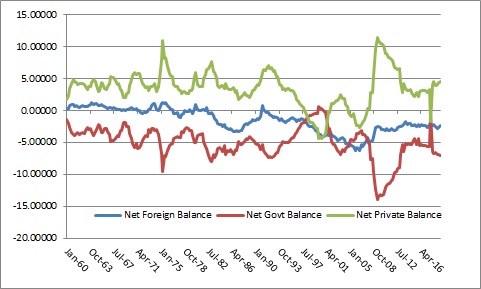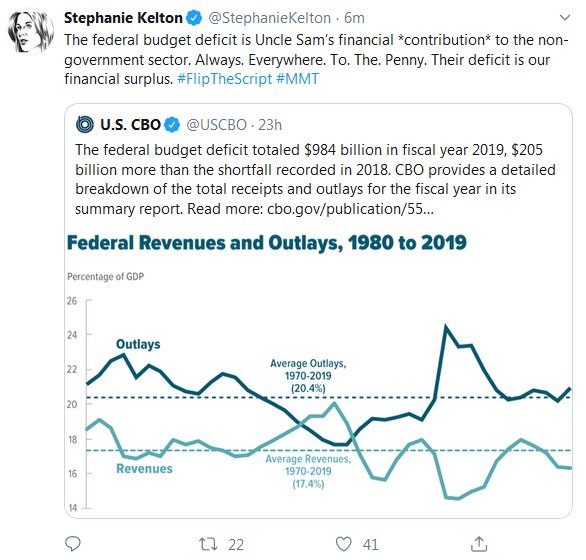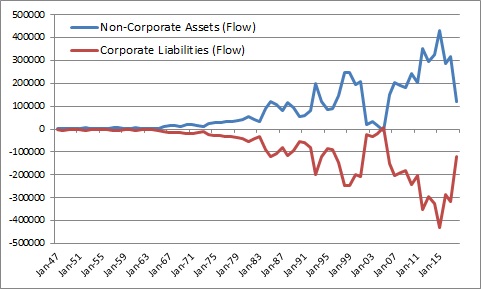I am a big fan of looking at things through the lens of the sectoral balances. For instance, I sometimes post this chart on this website which depicts the government’s balance vs the non-government.

(This is a stupid chart without a lot more context)
It’s a decent (though incomplete) depiction of the private sector’s balance versus the government’s position and it’s helpful to understand because, mainly, if you believe the private sector is too heavily indebted, then the government’s position might be insightful. For example, I would argue that the 2006 housing bubble was a period of concern because there was a housing market bubble and heavily leveraged consumers combined with a negative private balance which created balance sheet recession risk. Balance sheet recessions are different from typical income based recessions because asset prices can become depressed and stay depressed for a very long time such as Japan in the late 1990s as households and corporations deleverage. And if policymakers understand this they might be able to ease some of that pain by leveraging up their own balance sheet temporarily to offset some of the pain.
While this concept can be useful in unique circumstances, there are economists who use this concept in a misleading manner nearly all the time. The worst abusers of this are the MMT people and they constantly use it to misrepresent how the monetary system works. So let’s discuss that a bit because it confuses a lot of people. For example, just yesterday Stephanie Kelton, an MMT economics professor, posted this image on Twitter saying the government’s deficit is the non-government’s surplus to imply that the government’s deficit necessarily adds to our savings. This can mislead the reader into thinking that the government must be in a deficit or that the private sector can only save if there’s a government deficit. This is very wrong.

Let’s deconstruct this a little bit because MMT’s depiction of this is mostly a fallacy of composition that tries to imply that the government must be running a deficit virtually all the time:
1) This is just an accounting identity. The government’s spending is someone else’s income. You could recreate a chart of this using any sectoral relationship. For instance, when I take out debt and spend the money that becomes someone else’s income. The Cullen Roche deficit is the non Cullen Roche surplus. It’s not helpful or insightful to run around saying that my deficit is everyone else’s surplus without a lot more context. After all, if we did this then we could run around posting silly charts like this one showing corporate debt and trying to imply that corporate debt is always good or always needs to be expanding. Sure, this might be partly true, but it’s not something we should lazily throw around.

(This is a stupid chart without a lot more context)
2) Who is “our”? The worst part about this chart’s depiction in MMT circles is the implication that the government is somehow an external entity. For instance, in his basic primer on MMT, Randall Wray says “Net private financial wealth equals public debt.” But Wray’s comment is true in only the most misleading context. We should be clear – ALL financial assets net to zero (including the government’s). The only thing we have left after netting all of this is non-financial assets. We all save, borrow and grow our wealth against other sectors. There are literally millions of individual sectors in the economy. All of these sectoral assets and liabilities net to zero so it’s misleading to strip out one sector and imply that this is the sector supplying all the savings. That’s simply not how it works at an aggregate level.
For example, let’s say we have no government yet, no monetary system yet and a community that wants to build a bunch of homes to live in. So we write up a bunch of debt contracts that can be used as forms of money to pay for the way we’ll build a bunch of homes. Let’s pretend that I make all these debt promises to pay other people so I take out loans and pay workers to build 5 houses. When we’re all done I have a bunch of debt (and 5 homes) and the workers have saved the money I paid them. In the MMT world we are no better off despite the fact that the workers have saved money and I now have a bunch of houses. Sure, our financial assets and liabilities net to zero, but we have real non-financial assets. We are, empirically, better off despite the fact that our financial assets net to zero.
So, in the MMT world you need Comrade Wray to come in and convince us all that we need a Home Owners Association so we can then have “net financial assets”. So we form a HOA and the HOA borrows money to make silly rules and they spend some of that money to make pretty signs posting the rules and the sign maker saves some of that income. Of course, the HOA is, in essence, the liability of its home owners because they’re the ones who are on the hook to make sure that the debt the HOA has can be funded and expanded if necessary. The HOA can create “net financial assets” that add to someone’s financial wealth, but at the aggregate level the HOA’s liabilities are every home owner’s liability even if those liabilities are depicted on the HOA’s balance sheet (after all, it is the home owners who are responsible for running, managing and sustainably funding the HOA). So, at the aggregate level all of these financial assets net out and the home owners aren’t necessarily better or worse off after the HOA has been formed unless you think pretty signs with silly rules are a net benefit to society.
In the MMT world the HOA is the government and we need an ever expanding HOA to make sure that the home owners all save enough. But the problem is that the HOA is effectively a liability of the home owners just like the government is effectively a liability of the people who form it. Sure, we might be better off with the HOA. I am certainly not saying that all government is bad. Not even close. But imagine creating an entire economic school around the idea that the HOA is the center of the housing community and that we absolutely rely on the HOA at all times to advance our community’s well-being. It’s a ludicrously incomplete depiction of how the world actually works.
Anyhow, I am building an actual house that isn’t in a HOA and I am getting zero government assistance during the process so I should probably get outside and get back to work creating actual non-financial wealth.

(Check out my non-financial assets!)
NB – I don’t mean to hate on HOAs. HOAs can be perfectly fine and serve a positive purpose. So can governments. But if your neighbors ever come to you and tell you that your well-being is dependent on everyone forming a HOA then you might want to tell them they’re full of crap.
NB 2 – The MMT people will respond to this by saying “but the HOA isn’t a currency issuer”. That doesn’t change anything about the accounting here. In fact, an HOA is essentially a highly localized government and in our example the HOA could be the currency issuer. But again, that doesn’t change anything about the accounting and it doesn’t mean that we need the HOA to be spending “net financial assets” in order for us to save or accumulate wealth.
Mr. Roche is the Founder and Chief Investment Officer of Discipline Funds.Discipline Funds is a low fee financial advisory firm with a focus on helping people be more disciplined with their finances.
He is also the author of Pragmatic Capitalism: What Every Investor Needs to Understand About Money and Finance, Understanding the Modern Monetary System and Understanding Modern Portfolio Construction.

